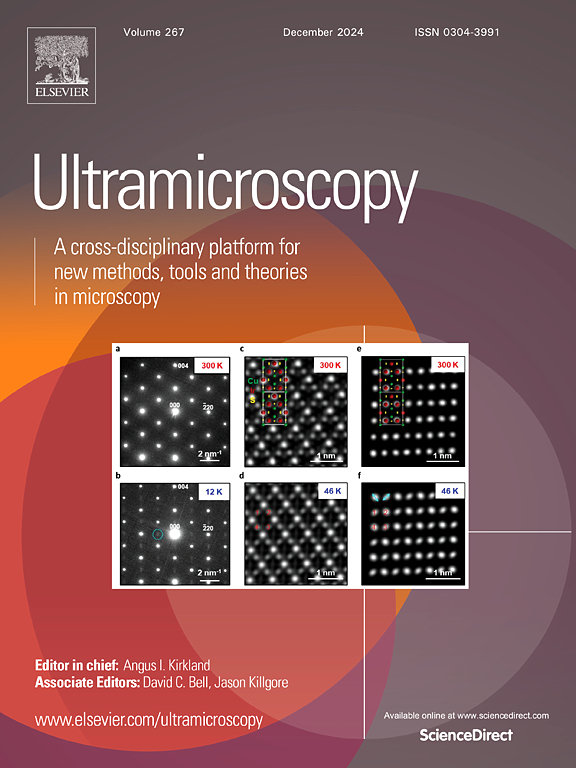Differentiating electron diffuse scattering via 4D-STEM spatial fluctuation and correlation analysis in complex FCC alloys
IF 2
3区 工程技术
Q2 MICROSCOPY
引用次数: 0
Abstract
Complex face-centered-cubic (FCC) alloys frequently display chemical short-range ordering (CSRO), which can be detected through the analysis of diffuse scattering. However, the interpretation of diffuse scattering is complicated by the presence of defects and thermal diffuse scattering, making it extremely challenging to distinguish CSRO using conventional scattering techniques. This complexity has sparked intense debates regarding the origin of specific diffuse-scattering signals, such as those observed at 1/3{422} and 1/2{311} positions. To address this challenge, we introduce the method of spatial fluctuation and correlation (FluCor) analysis of local diffuse scattering captured using Four-Dimensional Scanning Transmission Electron Microscopy (4D-STEM). We demonstrate our methodology using a solution-treated (CrCoNi)93Al4Ti2Nb medium-entropy alloy (MEA) and show that the FluCor analysis can differentiate diffuse scattering of different origins. The results reveal two sets of overlapping diffuse-scattering signals at the 1/3{422} and 1/2{311} positions in the studied MEA and link both to non-CSRO origins. Specifically, the heterogeneous-domain diffuse-scattering signals are attributed to nanoscale planar defects, while the homogeneous diffuse-scattering of the matrix is best explained by thermal-diffuse scattering. The principles underlying our fluctuation and correlation analysis of diffuse scattering are general and broadly applicable to order-disordered crystals, including various complex alloy systems. This versatility promises to yield valuable insights into the interplay between microstructural characteristics and CSRO behavior in a wide range of materials, potentially resolving long-standing debates in the field.
基于4D-STEM空间波动和相关分析的复杂FCC合金中电子漫射的鉴别
复杂面心立方(FCC)合金经常显示化学短程有序(CSRO),这可以通过漫射散射分析来检测。然而,漫射散射的解释由于缺陷和热漫射的存在而变得复杂,使得使用传统的散射技术来区分CSRO极具挑战性。这种复杂性引发了关于特定扩散散射信号起源的激烈争论,例如在1/3{422}和1/2{311}位置观测到的信号。为了解决这一挑战,我们引入了四维扫描透射电子显微镜(4D-STEM)捕获的局部漫射散射的空间波动和相关(FluCor)分析方法。我们用溶液处理的(CrCoNi)93Al4Ti2Nb中熵合金(MEA)证明了我们的方法,并表明fluor分析可以区分不同来源的漫射散射。结果显示,在研究的MEA的1/3{422}和1/2{311}位置上存在两组重叠的扩散散射信号,并将它们与非csro起源联系起来。具体来说,异质域扩散散射信号归因于纳米级平面缺陷,而基体的均匀扩散散射最好用热扩散散射来解释。我们的漫射散射涨落和相关分析的基本原理是通用的,广泛适用于有序无序晶体,包括各种复杂合金体系。这种多功能性有望对各种材料的微观结构特征和CSRO行为之间的相互作用产生有价值的见解,可能解决该领域长期存在的争论。
本文章由计算机程序翻译,如有差异,请以英文原文为准。
求助全文
约1分钟内获得全文
求助全文
来源期刊

Ultramicroscopy
工程技术-显微镜技术
CiteScore
4.60
自引率
13.60%
发文量
117
审稿时长
5.3 months
期刊介绍:
Ultramicroscopy is an established journal that provides a forum for the publication of original research papers, invited reviews and rapid communications. The scope of Ultramicroscopy is to describe advances in instrumentation, methods and theory related to all modes of microscopical imaging, diffraction and spectroscopy in the life and physical sciences.
 求助内容:
求助内容: 应助结果提醒方式:
应助结果提醒方式:


